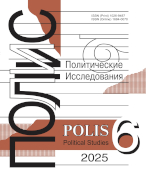Telegram channels in the electoral battle:
the peculiarities of civic activism development in the context of Belarus’s political crisis in 2020
Zuykina K.L.,
Lomonosov Moscow State University, Moscow, Russia, chris-zu@ya.ru
elibrary_id: 1076473 | ORCID: 0000-0002-2199-197X | RESEARCHER_ID: GLU-6336-2022
Article received: 2021.09.03. Accepted: 2022.03.25
DOI: 10.17976/jpps/2022.05.05
Zuykina K.L. Telegram channels in the electoral battle: the peculiarities of civic activism development in the context of Belarus’s political crisis in 2020. – Polis. Political Studies. 2022. No. 5. https://doi.org/10.17976/jpps/2022.05.05
The results of an empirical research on political communications through Belarusian telegram channels during the country’s political crisis in 2020 are presented in this article. The paper’s theoretical framework is based on J. Theocharis’ and J. Van Det’s perspectives on digital political engagement, the concept of “network thinking” (V. Kurbatov; E. Pronina), as well as previous research related to the study of the messenger’s role in Belarusian protest communication. The article is based on almost 2 thousand posts in eight crucial Belarusian political telegram channels of diverse political viewpoints. The empirical base was gathered over the course of two weeks, both before and after the election (August 9, 2020). The model led to original findings on how communication strategies of channels and methods for engaging citizens have evolved in light of the current agenda. The study’s principal method was qualitative and quantitative content analysis, with aspects of event analysis. The findings revealed that pro-government channels followed a value-oriented strategy (“similarity mode”), attempting to appeal to common representations of fundamental Belarusian values. Simultaneously, the channels had to reestablish communication to protest in the post-election period, conducting counterpropaganda and “mirroring” the agenda of opposition channels. Opposition channels employed an exposure approach, portraying the existing government’s activities in a negative light and appealing to the common good that would be achieved following the change of authority (“regime of criticism and justification”). Initially, opposition channels concentrated on multimedia “niche” content, frequent updates and the development of methods for mobilizing citizens and delivering necessary instructions. In contrast to pro-government channels, the opposition channels were able to sustain consistent indicators of user engagement due to the established communication policy.
References
Batsell, J. (2015). Engaged journalism: connecting with digitally empowered news audiences. New York, NY: Columbia University Press.
Bennett, W.L., Segerberg, A., & Walker, S. (2014). Organization in the crowd: peer production in largescale networked protests. Information, Communication & Society, 17(2), 232-260. https://doi.org/10.1080/1369118X.2013.870379
Boichak, O., & Jackson, S. (2019). From national identity to state legitimacy: mobilizing digitally networked publics in Eastern Ukraine. Media, War & Conflict, 13(3), 258-279. https://doi.org/10.1177/1750635219829161
Boulianne, S., Koc-Michalska, K., & Bimber, B. (2020). Mobilizing media: comparing TV and social media effects on protest mobilization. Information, Communication & Society, 23(5), 642-664. https://doi.org/10.1080/1369118X.2020.1713847
Castells, M. (2011). Democracy in the age of the Internet. Journal of Contemporary Culture, 6, 96-103.
Chu, D. (2018). Media use and protest mobilization: a case study of umbrella movement within Hong Kong Schools. Social Media + Society, 4(1). https://doi.org/10.1177%2F2056305118763350
Jost, J., Barbera, P., Bonneau, R., Langer, M., Metzger, M., Nagler, J., Sterling, J., & Tucker, J.A. (2018). How social media facilitates political protest: information, motivation, and social networks. Political Psychology, 39(1), 85-118. https://doi.org/10.1111/pops.12478
Jenzen, O., Erhart, I., Eslen-Ziya, H., Korkut, U., & McGarry, A. (2021). The symbol of social media in contemporary protest: Twitter and the Gezi Park movement. Convergence: The International Journal of Research into New Media Technologies, 27(2), 414-437. https://doi.org/10.1177%2F1354856520933747
Juris, J.S. (2005). The new digital media and activist networking within anti-corporate globalization movements. The Annals of the American Academy of Political and Social Science, 597, 189-208. https://doi.org/10.1177%2F0002716204270338
Kelly, K. (2016). The inevitable: understanding the 12 technological forces that will our future. New York, NY: Viking.
Kharroub, T., & Bas, O. 2016. Social media and protests: an examination of Twitter images of the 2011 Egyptian revolution. New Media & Society, 18(9), 1973-1992, https://doi.org/10.1177/1461444815571914
Langer, A.I., & Sagarzazu, I. (2018). Bring back the party: personalisation, the media and coalition politics. West European Politics, 41(3), 472-495. https://doi.org/10.1080/01402382.2017.1354528
Nikiporets-Takigawa, G. (2013). Tweeting the Russian protests. Digital Icons: Studies in Russian, Eurasian and Central European New Media, 9, 1-25.
Pearce, K., & Guliyev, F. (2015). Digital knives are still knives. In The Routledge Companion to Social Media and Politics (pp. 235-247). New York, NY: Routledge. http://dx.doi.org/10.4324/9781315716299-17
Shkade, D., Sunstein, R.C., & Hastie, R. (2007). What really happened on Deliberation Day? California Law Review, 95(3), 915-940.
Shifman, L. (2013). Memes in digital culture. London: The MIT Press.
Theocharis, Y. (2015). The conceptualization of digitally networked participation. Social Media + Society, 1(2), 1-14. https://doi.org/10.1177/2056305115610140
Theocharis, Y., & Van Deth, J. (2018). The continuous expansion of citizen participation: a new taxonomy. European Political Science Review, 10(1), 139-163.
Van Deth, J.W. (2014). A conceptual map of political participation. Acta Politica, 49, 349-367. https://doi.org/10.1057/ap.2014.6
Trer´e, E. (2018). Hybrid media activism: ecologies, imaginaries, algorithms. London: Routledge.
Brodovskaya, E.V., Nikulin, E.R., & Davydova, M.A. (2021). Mass political protests in the Republic of Belarus in summer – autumn 2020: causes, social base, digital infrastructure. Journal of Political Research, 5(1), 23-35. (In Russ.)
Boltanski, L., & Thevenot, L. (2000) The sociology of critical capacity. Journal of Sociology and Social Anthropology, 3(3), 66-83. (In Russ.)
Di, C. (2013). Social networks and their influence on events in the Arab states (2010-2013). Vestnik of Saint Petersburg University, 4, 189-194. (In Russ.)
Gladarev, B.S. (2012). Gradozashchitnye dvizheniia Peterburga nakanune “Zimnei revoliutsii” 2011–2012 gg.: analiz perspektivy frantsuzskoi pragmaticheskoi sotsiologii [City protective movements in St. Petersburg before the “Winter revolution” of 2011-2012: analysis of the prospects of the French pragmatic sociology]. Monitoring of Public Opinion: Economic and Social Changes, 4(10), 29-43. (In Russ.)
Kovalev, E.M., & Stemberg, I.E. (1999) Qualitative methods in sociological fieldwork. Moscow: Logos. (In Russ.)
Kurbatov, V.I. (2017). Net-thinking: new reality of information age. Humanities of the South of Russia, 6(6), 173-181. (In Russ.) https://doi.org/10.23683/2227-8656.2017.6.14
Nagornyak, K.I. (2021). Activity of opposition Telegram channels and behavioral factor of Google users as a research method for analyzing the protests in Belarus in 2020. RUDN Journal of Political Science, 23(1), 60-77. (In Russ.) https://doi.org/10.22363/2313-1438-2021-23-1-60-77
Platonov, Yu.P. (2008). Gruppovye jeffekty i metody povyshenija jeffektivnosti sovmestnoj raboty. [Group effects and methods to improve the effectiveness of teamwork]. Center for Humanitarian Technologies. (In Russ.) https://gtmarket.ru/library/articles/4934
Ponomareva, E.G. (2021). The protest movement in Belarus: evolution, technology, symbols. – Scientifically-analytical Journal “Observer”, 2, 5-28. (In Russ.)
Pronina, E.E. (2002). Psihologija zhurnalistskogo tvorchestva [Psychology of journalistic creativity]. Moscow: MSU Publ. (In Russ.)
Vanke, A., Ksenofontova, I., & Tartakovskaya, I. (2014). Internet communications as a means and a condition of political mobilization in Russia: case of the “for fair elections”. Interaction. Interview. Interpretation, 6(7), 44-73. (In Russ.)
See also:
Shestopal E.B.,
Introducing the section. The human dimension of politics. – Polis. Political Studies. 2013. No6
Bykov I.A., Hall T.E.,
Digital divide and the Internet-users political preferences in Russia. – Polis. Political Studies. 2011. No5
Linetsky A.I.,
Variety of political systems as consequence of differences in people’s behavior. – Polis. Political Studies. 2013. No6
Radina N.K.,
Digital Political Mobilization of Online Commenters on Publications about Politics and International Relations. – Polis. Political Studies. 2018. No2
Shevchenko A.V.,
Stability of political system: homo communicativus vs homo politicus. – Polis. Political Studies. 2009. No5




.jpg)






 print
print
.jpg)
.jpg)